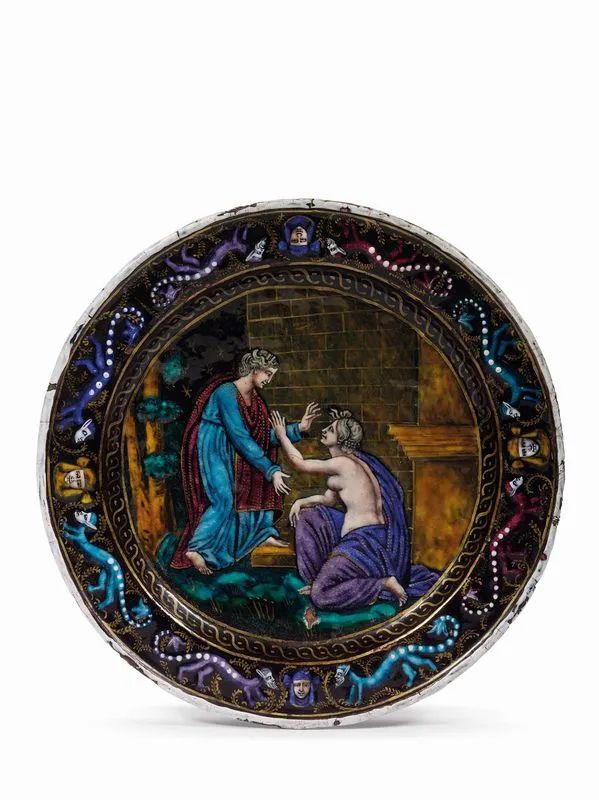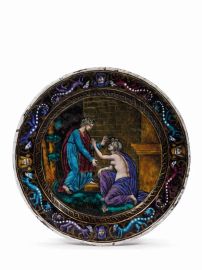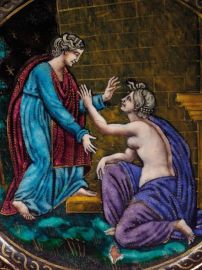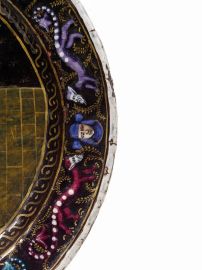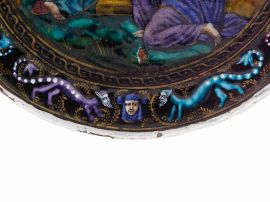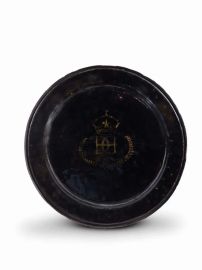Limoges, mid-16th century
JUNO REJECTING PSYCHE
Copper plate with enamel and gold, 21 cm diameter
On the back, gold-painted monogram placed between leafed branches, surmounted by a crown
Footless, this plate presents a wide flat cavetto and an ample horizontal brim, entirely painted in polychrome with cold gilding. The centre of the scene is occupied by two goddesses, placed in front of a palace with leafed trees and a starry sky in the background: Juno receives Psyche, who is kneeling down before her and imploring her, but Juno must reject her so as not to wrong Venus. The scene is framed by a gold-painted band arranged into a twisted ribbon motif, surrounded by the grotesques decorating the brim, which features four couples of salamanders with satyr-like visages, each couple alternating with a total of four female faces, and surrounded by gilded branches.
The scene is a faithful reproduction of an engraving by Maestro del Dado (fig. 1), drawn from the cycle of “The Story of Psyche” (n.20), which includes works deriving from drawings inspired by Raffaello and attributed by Vasari to Michel Coxie, whom Maestro del Dado met in Rome in 1523, which is when the cycle is dated from. These drawings echo similar frescoes found in the Loggia of the Farnesina, which were destroyed during the 1527 Sack of Rome. The myth, recounted by Apuleius in his Metamorphoses (books IV-VI) and included by Boccaccio in the Genealogia Deorum, tells the story of Psyche and Cupid. Venus, jealous of Pysche’s great beauty, charges her son Cupid with making her fall in love with the ugliest man on earth. The mission however fails, and Cupid himself ends up falling for Psyche. Through the intercession of an oracle, he manages to keep her shut away in a castle where he visits her only under cover of darkness. However, Psyche, instigated by her sisters, breaks the rule against looking at her lover’s face. Cupid feels betrayed and abandons her. Torn apart by pain, Psyche attempts suicide many times, but is always saved by the gods, until she decides to go to the temple of Venus to ask for her help. The goddess, Cupid’s mother, subjects Psyche to a number of trials through which she will regain the love of her son. Only at the end of the story, exhausted both physically and mentally, does Psyche receive the assistance of Jove, who, moved to compassion, makes it so that the two lovers are reunited. Psyche becomes a goddess and marries Cupid at a feast on Mount Olympus.
The back of the plate, decorated in the centre with a monogram placed between laurel branches and surmounted by a lilied crown, immediately appears to be a reference to the French king Henry II (fig. 2) and his lover Diana of Poitiers, as well as to the castle of Anet. Diana, first born of John of Poitiers, married Louis of Brézé, Count Maulevrier, in 1515, and bore him two sons. Widowed in 1531, she became a few years later the favourite of the Duke of Orleans, who would later become king under the name Henry II. Diana was able to draw full advantage from her position as the king’s favourite, so much so that even Catherine de’ Medici had to yield to her influence. Not only did she receive the Duchy of Valentinois and the castle of Chenonceau as gifts from the king, but she even had him finance the construction of the new castle of Anet, designed by Philibert Delorme, France’s most famous architect of the time, in 1547 (fig. 3). A replica of a bronze alto-relievo by Benvenuto Cellini (the original is found today in the Louvre) was placed at the gate of the suburban palace, depicting a nymph or perhaps the goddess Diana, naked and beautiful, exhausted by the hunt, as a clear reference to the handsome lady of the castle.
The precious character of this artefact is further confirmed by the technique of its execution: enamel, coupling vitreous pastes and metallic surfaces, used as support, through a process of oven melting. This technique lies in between those of the glassmaker and goldsmith, and is used whenever it is necessary to add colour to precious metals. The plaque is covered in melt on both sides and is heated a first time; the downside is thus protected while the upside may be decorated through the superimposition of different layers of coloured enamel, laid over with a spatula, with successive further heating which melds together the enamel. Applying colour with a brush allows to highlight certain details, whilst thin sheets of silver- or gold-leaf, called “paillons”, give the piece a notable brightness. Known since antiquity, the enamel technique evolved over the centuries until, over the course of the 12th century, the “champlevé” procedure was introduced, in which the use of enamel prevails over that of metal until the latter virtually disappears from the picture. The first half of the 14th century saw the progressive affirmation of painted enamel, which given its pictorial character could draw on the models already used by painting and iconography, including prints and drawings. Usually, the drawing was executed in bistre black with a paintbrush on the “fondant” white enamel base. Later, following the lines thus traced, the coloured enamel would be applied with the spatula, so that after heating the effect would be similar to that of a pen-drawing. Precisely Limoges, in central France, was – from the middle ages to the 17th century – one of the main European centres of enamel production. Particularly interesting are Renaissance enamels, produced principally during the 16th century, when the art of using enamel was renovated according to contemporary taste by master artists, such as Léonard Limosin, who invented a technique for painting with enamel on copper tablets.

